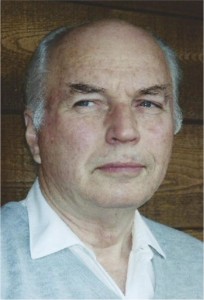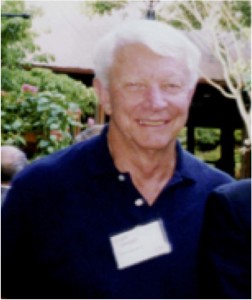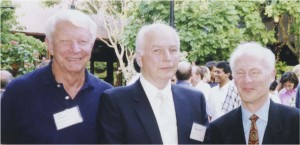Kenneth Radford Shoulders
Memorial lecture at IVNC 2014
 Ken Shoulders was born in 1927 and died June 7. 2013 from cancer. He was 86.
Ken Shoulders was born in 1927 and died June 7. 2013 from cancer. He was 86.
He left behind his wife Claire, daughters Diane Meade and Lee Shoulders, son Steven Shoulders and grand-daughters Madeleine and Hannah. His daughter Diane stated after his death:
“Ken’s brilliance will be missed in the scientific community as a visionary in the field of new energy exotic vacuum objects (EVO’s). He was a leader in this new frontier, but perhaps best known to the scientific community as the father of vacuum microelectronics.”
He worked at MIT (during this time he fabricated the world’s first microcircuits) and later did some exotic and confidential work for the CIA and others. Ken has a history of working at the edge of science and engineering. He worked at SRI International for ten years as a staff scientist and started a field now called vacuum nanoelectronics, which is based on field emission active devices.
Ken was also admired for his earlier work for SRI International , at Menlo Park , CA, USA, which resulted in many patents. Other inventions that were based on Ken’s designs were the first commercially available quadrupole mass spectrometer, which he built in 1958 at SRI, and was then developed by Finnigan Instruments.
Shoulders also stated at that times that it is better to develop electronics with free flying electrons, than develop transistors, where the electron velocity is much slower due to the ion cores retracting the electrons in the solid material and semiconductors.
At SRI he then started to construct vacuum systems for evaporation processes as well as for multi-beam exposures of patterns of holes to develop the Spindt cathode array.
Other areas of devotion to science included vertical, flight technology, which remained an unfinished passion at his death.
Ken will be greatly missed , but his ground-breaking work in a new energy will be built on and come to pass when the rest of the world catches up to this vision. Shoulders was an independent-thinking genius who only finished high school, but who had a flare for thinking outside the box.
He was an unschooled scientific genius who bubbled with wild ideas at an astounding rate. Before coming to SRI, he had worked at MIT as a technician. Sometime later, he was informally voted the SRI researcher most likely to build a perpetual motion machine.
Capp Spindt from SRI Menlo Park CA USA did send this message:
I just got the news that Ken Shoulders, the internationally recognized “father of vacuum microelectronics” and the guy that hired me at SRI in 1959 has died…He was not only my “boss”, but also a mentor, colleague, and friend – He was a true genius, and always way ahead of all of us in every way. We often couldn’t grasp or even understand what he envisioned or claimed to have seen, but over time it always turned out that he was right… A most amazing person.
He went to the world famous Prof. Feynman (of the Los Alamos “Manhattan project” and Cal Tech. fame) with his electron cluster concepts (that flew in the face of “conventional wisdom” and baffled us all), and was dismissed as a nut… . But later Feynman wrote a letter to Ken saying that he’d been thinking about it, and had discovered an explanation for his observations and theory and that Ken was correct after all. Most amazing – he was even ahead of Feynman. Once again we (everyone) were all wrong, and Ken was right.
The site here will give you a brief look at what it’s like to be with a true genius. I was very privileged. He did much, and left much for us to try to finish.
His friend John Hutchinson spoke with Ken Shoulders about the inherent conflict between exploratory science and academic science. (In an Video Interview)
“In academic science that’s all you are doing, piecing together things that you can pick up, Shoulders said. However he is working on something you cannot look up! You cannot piece it together. You cannot find the parts in books.”
That is the kind stuff Ken worked on and he new the rule:
“You guys are wrong; you cannot get the kind of answers you want doing things the way you do them”. And why do they say that?”
Because they are afraid of losing their academic connections.
“What we have to do in our field to make progress is to be very non-academic. Anyone that is in frontier science, anyone that is out there, in exploratory science, you cannot tolerate rules of academia. They will perish, they won’t find anything of value. It’s so easy not to find stuff, and you’ll never even know what you didn’t find.”
Sholders worked in some most exciting uncharted territories, including novel flight mechanisms as well as remote viewing research sponsored by the CIA. At one time, Shoulders stated in the video, he was discussing possible research collaborations but no one payed his work and living.
It was extremely difficult to convince people with money to support the basic exploration of novel effects, with no real vision of a possible product. That was after Ken did quit SRI as a CTO and wanted to go on with his own work, possibly around 1987.
He looked for money, as he said, and found the Prince, as he told me in 1989. This was a wealthy man who was very much excited about any kind of research .
This man asked Ken: I understand you are a physicist, an enlightened researcher, you look for unknown things, you cannot think of what you will find tomorrow, therefore you cannot make a plan, no research plan or even a business plan for your so far unknown product.
But, all your work costs money! Tell me, how much is it? What do you need to do your work? Tell me how much money it is? Don’t be shy- tell me!!! – And Ken finally told him and made this man happy to support his research work for the next 25 years, including the living costs for the two families on the farm in Bodega, CA.
This had a large barn on the farm in the rolling hills, well suited for a good laboratory with everything which was needed for experiments and documentation. There the Shoulders settled with their son and his family, who also worked with Ken. The laboratory got high precision machining tools, ovens , SEM, vacuum systems and microscopes, as well as uninterrupted power supply with emergency backup, a computer connection to the Universities of California and, for the breaks to think and relax, a small garden and a flock of vultures, which he and his families observed and fed.
The Prince was a real prince, the Prince Hans- Adam II of Liechtenstein, a television-magnat.
The lab ended up being bigger than the house. Its size was 4000 square foots, a fully equipped machine shop, and two trailors full of scientific equipment, some of them custom built.
It was beautiful, he could build things that Lawrence Livermore could not build.
In our discussion in 1989 on the farm in Bodega, Ken proposed an idea to improve the stability of the field emitter electron emission by building an oscillator circuit into the emitter tip, which could limit the extraction voltage and therefore protects the tip. Ken wished to offer this, his patented idea, to Motorola, Candescent, Pixtech, Micrion and HP. However, he was not accepted with the argument, now all of these companies have introduced a technology to build within a year a functioning field-emitter flat panel display. This allows no time for research or developments, and therefore is not wished. The idea of the companies was to use the few cathodes, which are produced in an overkill large number per pixel and to build the FED’s with those.
The variation to protect the tips by an oscillating voltage against the often happening burn out was never followed.
In a second project Ken wanted to cooperate with researchers from Germany knowing about the physics of Pseudo-spark- discharges, especially using massive parallel Pseodo-spark discharges, which should allow to irradiate larger areas with many very energetic particles at once. Since the high energy plasma radiation possesses a huge penetration capability and ejects the in the channel molten matter in the forward direction to deposit the matter in an low energy mode on a target, the idea was born to use this radiation to convert waste reaction products from nuclear reactors. Since the particle beams even released neutrons , what he observed and detected in his lab, Shoulders wished to employ this technology in the cleanup process of nuclear waste. The task was given and supported by the government.
The main field of work of Ken Shoulders in the times after his work at SRI was the exploration of Charge Clusters: EVO’s. These are compact groups of millions of electrons. They defy the common belief that such things cannot occur because of the great repelling forces these electrons should exert on each other. Yet they do appear to exist and are not even that difficult to create, once you know how. Ken Shoulders knows how and has been doing it for about 25 years.
Ken and his son Steve experiment with charge clusters (also called exotic vacuum objects or EVOs) in their well-equipped, privately funded lab in California.
Ken’s very qualified background has helped convince many people that the EVO phenomenon is real, in spite of the difficulty in believing that electrons can form such clusters.
Ken notes: “Nobody believed anything ever said. They only believed the gadgets that were run by EVs. I actually had to almost beat the patent office into submission by a series of brutal assaults with my devices!“
Not only are the clusters themselves exotic to mainstream science but they seem to offer a way of connecting to the most fundamental and universal element of existence, sometimes called the aether. Ken refers to this as the Potentum, a name given by Joe Firmage. Whatever the name, it is a little understood part of the universe that many agree is loaded with energy if we only knew how to tap into it. The EVO may be the fundamental connecting link. Ken considers it a “kind of Universal Clutch as it clutches the basic fabric of the universe by biasing the medium with a dense, asymmetrical charge distribution.” This is a very powerful concept and may well be the foundation of any device that operates with an “efficiency” over-unity.
This clutch apparently can operate in many environments. EVOs are likely the Source of the extremely high temperatures recently measured in collapsing bubbles formed by cavitations’. Temperatures as high as 20,000 degrees K have been measured. Temperatures in this range need an exotic explanation and EVOs exhibit extremely high temperatures. Sonofusion is likely triggered by the same mechanism and may not really qualify as “cold” fusion. The destructive effects of cavitation on marine propellers has been known for over 150 years but never explained satisfactorily.
Likewise the cavitation that can occur in pumps. There have been many claims of over-unity performance in pumps designed to produce a lot of cavitation but never enough to be useful as an energy source because the input is electrical and the output is heat at moderate temperatures.
Tesla is known to have been able to create what appeared to be ball lightning and even was able to let it touch him without harm. Ball lightning is probably a large charge cluster. It is not well understood but can appear in lightning storms, coming and going in mysterious ways, sometimes quietly and sometimes with a great deal of commotion. Understanding charged clusters better may clarify some of Tesla’s work as well as give a better understanding of a strange natural phenomenon.
He also worked on Highest frequency puls generation using pseudo-spark radiation and interaction with microstructures. He also hoped for light generation by coupling out photons generated by the plasma beam when hitting matter, and he offered consulting work for further activities in plasma research.
He also wrote routinely on his research and progress and ideas , which was placed in the internet under : http://www.svn.net/krscfs/
Since he passed last year, now, after all the years his equipment is packed and shall support further researchers, who can tell their wish by e-mail to New Energy Times.

